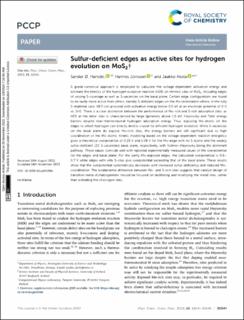| dc.contributor.author | Hanslin, Sander Øglænd | |
| dc.contributor.author | Jónsson, Hannes | |
| dc.contributor.author | Akola, Jaakko Eemeli | |
| dc.date.accessioned | 2024-02-08T09:43:59Z | |
| dc.date.available | 2024-02-08T09:43:59Z | |
| dc.date.created | 2023-12-18T08:52:58Z | |
| dc.date.issued | 2023 | |
| dc.identifier.issn | 1463-9076 | |
| dc.identifier.uri | https://hdl.handle.net/11250/3116320 | |
| dc.description.abstract | A grand-canonical approach is employed to calculate the voltage-dependent activation energy and estimate the kinetics of the hydrogen evolution reaction (HER) on intrinsic sites of MoS2, including edges of varying S-coverage as well as S-vacancies on the basal plane. Certain edge configurations are found to be vastly more active than others, namely S-deficient edges on the Mo-termination where, in the fully S-depleted case, HER can proceed with activation energy below 0.5 eV at an electrode potential of 0 V vs. SHE. There is a clear distinction between the performance of Mo-rich and S-rich adsorption sites, as HER at the latter sites is characterized by large (generally above 1.5 eV) Heyrovsky and Tafel energy barriers despite near-thermoneutral hydrogen adsorption energy. Thus, exposing Mo-atoms on the edges to which hydrogen can directly bind is crucial for efficient hydrogen evolution. While S-vacancies on the basal plane do expose Mo-rich sites, the energy barriers are still significant due to high coordination of the Mo atoms. Kinetic modelling based on the voltage-dependent reaction energetics gives a theoretical overpotential of 0.25 V and 1.09 V for the Mo-edge with no S atoms and the weakly sulfur-deficient (2% S-vacancies) basal plane, respectively, with Volmer–Heyrovsky being the dominant pathway. These values coincide well with reported experimentally measured values of the overpotential for the edges and basal plane. For the partly Mo-exposed edges, the calculated overpotential is 0.6–0.7 V while edges with only S-sites give overpotential exceeding that of the basal plane. These results show that the overpotential systematically decreases with increased sulfur-deficiency and reduced Mo-coordination. The fundamental difference between Mo- and S-rich sites suggests that catalyst design of transition metal dichalcogenides should be focused on facilitating and modifying the metal sites, rather than activating the chalcogen sites. | en_US |
| dc.language.iso | eng | en_US |
| dc.publisher | Royal Society of Chemistry Publishing | en_US |
| dc.rights | Navngivelse 4.0 Internasjonal | * |
| dc.rights.uri | http://creativecommons.org/licenses/by/4.0/deed.no | * |
| dc.title | Sulfur-deficient edges as active sites for hydrogen evolution on MoS<inf>2</inf> | en_US |
| dc.title.alternative | Sulfur-deficient edges as active sites for hydrogen evolution on MoS<inf>2</inf> | en_US |
| dc.type | Peer reviewed | en_US |
| dc.type | Journal article | en_US |
| dc.description.version | publishedVersion | en_US |
| dc.source.pagenumber | 0 | en_US |
| dc.source.volume | 47 | en_US |
| dc.source.journal | Physical Chemistry, Chemical Physics - PCCP | en_US |
| dc.identifier.doi | 10.1039/d3cp04198k | |
| dc.identifier.cristin | 2214609 | |
| dc.relation.project | Sigma2: NN9497K | en_US |
| cristin.ispublished | true | |
| cristin.fulltext | original | |
| cristin.qualitycode | 2 | |

